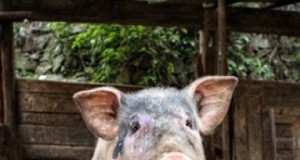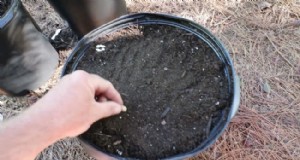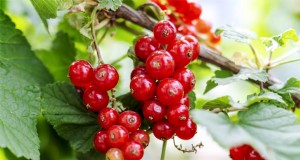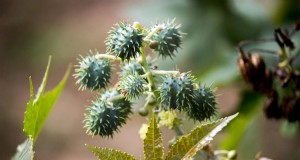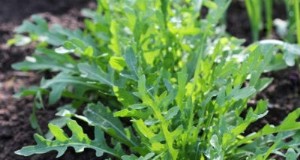INTRODUCCIÓN AL CULTIVO DE ESPECIAS:
Cultivo de especias:la especia es una sustancia que se utiliza en los alimentos con el propósito de dar sabor, color o conservación. Las diferentes especias se obtienen de diferentes partes de una planta o árbol, como semillas, ladridos raíces y frutos. Se espera que algunas especias tengan propiedades antimicrobianas y antibacterianas. El uso de algunas especias se encuentra en cosmética, rituales religiosos, medicinas y perfumes. Se considera que las diferentes especias proceden de diferentes países del mundo. La canela y la pimienta negra se originaron en el sur de Asia y Oriente Medio, clavos durante la civilización mesopotámica, nuez moscada de las islas Banda en el sudeste asiático. La demanda de especias fue mayor en Europa durante la Edad Media. Durante este período se importaron especias de Asia y África. En el período moderno, hubo una gran demanda de mercado de la pimienta en la India. El principal problema con las especias en estos días es la dilución. La calidad de las especias se ha vuelto inferior debido a la adulteración (mezcla de otros productos no deseados en la mezcla original).
Las diferentes formas de especias son frescas, seco y en polvo. Las especias generalmente están disponibles en su forma seca para una mayor facilidad de uso y una vida útil más prolongada. Hay algunas especias que cuando se usan frescas dan más esencia que las secas como el jengibre. Las especias como la cúrcuma siempre se utilizan en forma de polvo. Las especias como el hinojo y la mostaza se utilizan tanto enteras como en polvo. El sabor de una especia se pierde cuando se expone al aire debido a la oxidación y la evaporación. Entonces, Se recomienda encarecidamente que las especias se almacenen enteras y se muelen cuando sea necesario para experimentar el máximo sabor. Las especias utilizadas para cocinar se agregan al principio de la preparación para que el sabor se infunda en los alimentos, a diferencia de las hierbas que se agregan al final de la preparación.
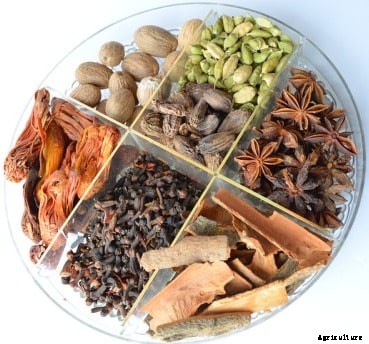 Prácticas de cultivo de especias.
Prácticas de cultivo de especias.
Se espera que las especias contengan calorías, porción de grasa, carbohidratos minerales, micronutrientes y proteínas. El comino y el jengibre exhiben una alta propiedad antioxidante que ayuda como conservantes naturales.
Las especias están contaminadas por una bacteria llamada salmonella. Algunas de estas bacterias son resistentes a los antibióticos y ahora se tratan con el método de esterilización por radiación.
CULTIVO DE ESPECIAS DE CURMERAS:
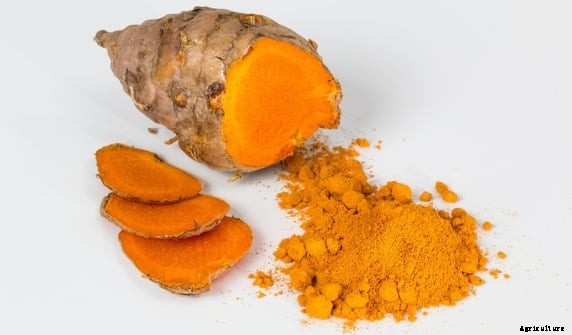 Cúrcuma.
Cúrcuma. - INTRODUCCIÓN: El nombre binomial de la cúrcuma es Curcuma longa y pertenece a la familia del jengibre. Se considera nativo del subcontinente indio. Este es un rizoma que se usa en forma de polvo seco. Tiene propiedades medicinales por lo que se utiliza para tratamientos antibacterianos. Es de color amarillo y tiene un aroma agradable.
- CONDICIONES DEL SUELO Y CLIMA PARA EL CULTIVO DE ESPECIAS DE CURMERAS: El suelo franco arenoso y arcilloso que tiene un rico contenido de humus y está bien drenado se utiliza para el cultivo de la cúrcuma. Se cultiva a nivel del mar o a elevación de 1500 m sobre el nivel del mar. Se estima que la temperatura de la región es 20-30 grados Celsius y el promedio las precipitaciones deben rondar los 1500-2250 mm
- PROPAGACIÓN: La cúrcuma se propaga a través de esquejes de rizoma que se plantan a fines de la temporada de invierno.
- PREPARACIÓN Y PLANTACIÓN DEL TERRENO: Los hoyos de 3 pulgadas de profundidad se hacen usando una azada manual y el el espacio entre filas es de 25 cm x 30 cm . Estos se cubren con tierra y estiércol seco de ganado. Las crestas y los surcos están espaciados a distancia de 45-60 cm entre filas y espaciados 25 cm para plantas.
- ABONO Y RIEGO: El estiércol de ganado a 40 toneladas / ha se utiliza ampliamente para el cultivo de cúrcuma. Dado que esta planta es de tipo riego, Requiere 15-20 ciclos para suelos pesados y 35-40 ciclos para suelos ligeros. FYM @ 10 toneladas / ha es necesario para el aderezo basal. La racion de N:P:K es 125:37:37 kg / ha.
- El mulching se hace dos veces con basura de caña de azúcar o verde. hojas a 12-15 toneladas / ha en un intervalo de 50 días.
- MANEJO DE ENFERMEDAD: el barrenador de los brotes está controlado por pulverización de malatión al 0,1% . La escala de rizoma se controla sumergiendo los rizomas en quinalfos al 0.1% antes de plantar. La pudrición del rizoma se controla usando ditano M-45 0,3% durante la preparación del suelo. La mancha foliar está controlada por pulverización 0,2% de dithane M-45 .
- COSECHA Y TRATAMIENTO: la cosecha se realiza después de 10 meses desde la siembra, cuando el rizoma madura. El clima cálido es bueno para la cúrcuma, por lo que si se siembra en octubre se cosecha en agosto. Los rizomas se hierven hasta que estén blandos y se secan al sol extendidos sobre esteras de bambú durante 15 días aproximadamente.
- PRODUCIR: En promedio, un acre de tierra rinde de 8 a 10 toneladas de cúrcuma.
CULTIVO DE ESPECIAS DE HOJA DE BAHÍA:
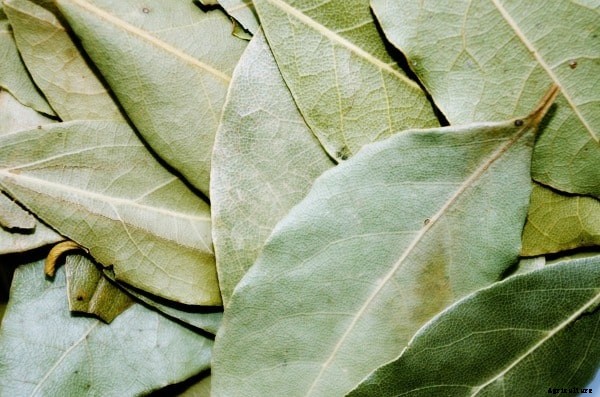 Hoja de laurel.
Hoja de laurel. - INTRODUCCIÓN: Hoja de laurel (Nombre binomial:Laurus nobilis). Se originó en el Mediterráneo y crece hasta una altura de 40 pies. Las plantas tienen hojas verdes de tamaño mediano. Se utiliza como aromatizante y como medicamento.
- CONDICIONES DEL SUELO Y CLIMA PARA EL CULTIVO DE ESPECIAS DE HOJA DE BAHÍA: La luz solar es una ventaja y el viento frío o las heladas pueden ser perjudiciales. El clima favorable es el clima mediterráneo cálido y húmedo. Un suelo bien drenado con suficiente materia orgánica es muy adecuado con un Rango de pH de 6-8.
- PROPAGACIÓN: Los brotes en capas o esquejes de raíces se utilizan para la propagación de la hoja de laurel.
- PREPARACIÓN Y PLANTACIÓN DEL TERRENO: La tierra se complementa con estiércol de corral y las malas hierbas se eliminan mediante el arado.
- ABONO Y RIEGO: El estiércol de corral podrido es útil para mejorar la riqueza del suelo. Se proporciona un suministro de agua adecuado mediante riego por goteo para mantener intacta la humedad del suelo.
- MANEJO DE ENFERMEDAD: Ácaros Los pulgones y las escamas duras son plagas que infectan el árbol y se controlan mediante la aplicación de aceite de neem. El aerosol de azufre previene las manchas negras y el daño de las hojas.
- COSECHA Y TRATAMIENTO: Dado que es una variedad de hoja perenne, las hojas están disponibles todo el año para la cosecha. Generalmente se secan antes de su uso.
- PRODUCIR: Una hectárea de tierra produce 6 toneladas de hojas.
CULTIVO DE NUTMEG Y MACE SPICE:
- INTRODUCCIÓN: la nuez moscada y la macis son productos del mismo árbol (nombre botánico:Myristica fragrans houtt). Este árbol es originario de Indonesia y ahora se cultiva en algunas partes de la India. Es un árbol de hoja perenne que está densamente foliado y crece hasta una altura de 20 m. Estas especias se utilizan para aromatizar alimentos, perfumes, preparación de aceites y mantequillas.
- CONDICIONES DEL SUELO Y CLIMA PARA EL CULTIVO DE ESPECIES DE NUTMEG: cálido, clima húmedo con lluvias anuales de 150 cm es necesario para estos árboles. La zona ideal es desde el nivel del mar hasta 1300 m sobre el nivel del mar. Las laderas de Ghats occidental y oriental son una buena opción para el cultivo de nuez moscada y macis. Suelo con arcilla, marga, La arena y la laterita roja son adecuadas para este árbol.
- PROPAGACIÓN: La semilla de los frutos de este árbol se utiliza para la propagación. El acodo aéreo y la gemación también son métodos exitosos de propagación, pero la tecnica de "injerto de epicotilo" es el más productivo.
- PREPARACIÓN Y PLANTACIÓN DEL TERRENO: cuando crezcan las plántulas, después 12 a 18 meses se trasplantan al área principal. Se cavan pozos cúbicos de dimensiones 60 cm y se rellenan con tierra vegetal y compost. El espacio entre pozos es 8 mx 8 m . La siembra se realiza durante la temporada de lluvias. Se requiere sombra durante los primeros años. El mulching se realiza con la basura disponible en los alrededores.
- ABONO Y RIEGO: El árbol requiere una gran cantidad de estiércol para un mayor rendimiento y crecimiento. Se utiliza FYM a 10 kg / planta durante el primer año. Un árbol de 15 años necesitaría unos 50 kg de estiércol. Nitrógeno a 20 gramos, fósforo @ 18 gramos y potasa @ 50 gramos se aplican a cada planta en el primer año. La dosis aumenta con la edad del árbol y se aplica dos veces al año; Mayo-junio y septiembre-octubre. El riego no es muy necesario.
- MANEJO DE ENFERMEDAD: La muerte regresiva causada por diplodianatalensis se controla aplicando la mezcla de Burdeos al final de las ramas. La luz del hilo es causada por Marasmius sp. se controla rociando el 1% de la mezcla de Burdeos. La pudrición de la fruta es causada por Phytophthora y Diplodia natalensis, que se controla mediante pulverización. 1% de Burdeos
- COSECHA Y TRATAMIENTO: Si se utilizan plántulas, el rodamiento comienza en 7-8 años, pero si se hace el injerto, el rodamiento comienza en 4-5 años. La producción completa se alcanza después de 15-20 años y rinde hasta 60 años. La recolección se realiza de junio a agosto. La maduración de la fruta se conoce cuando la cáscara carnosa se abre. La maza se separa de la nuez y se seca lentamente al sol durante 10-15 días. La semilla también se seca por separado durante 4-8 semanas al sol o mediante procesos artificiales. Se quita la cáscara exterior y se saca la tuerca.
- PRODUCIR: La producción promedio de un solo árbol es de 2000-3000 frutos por año. Se espera que una hectárea de tierra pueda producir 800 kg de nuez moscada y 100 kg de macis.
CULTIVO DE ESPECIAS DE ANIS ESTRELLA:
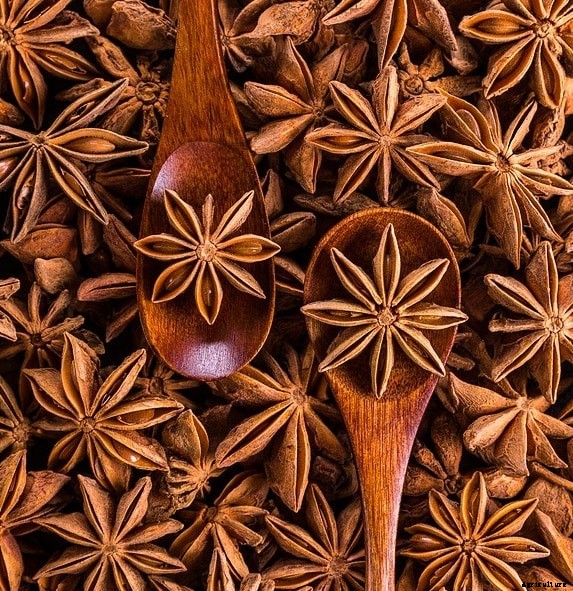 Anís estrellado.
Anís estrellado. - INTRODUCCIÓN: Esta especia recibe su nombre de la forma. Su nombre botánico es Illicium verum. Siberia se considera ideal para el cultivo de anís. Esta es una especia de color marrón oscuro con fuerte aroma. Esto también se llama anís y tiene propiedades medicinales. Es un árbol de hoja perenne y crece hasta una altura de 5-10 m.
- CONDICIONES DEL SUELO Y CLIMA PARA EL CULTIVO DE ESPECIAS DE ANIS ESTRELLA: Los suelos ricos en humus o ligeramente ácidos son los más adecuados para el cultivo de anís. Requiere clima subtropical donde la temperatura no sea inferior a -10 grados Celsius. La planta necesita un clima cálido y soleado donde no haya vientos secos o fríos. El PH del suelo es 6-6,7.
- PROPAGACIÓN: La propagación se realiza sembrando semillas o esquejes directamente. La temperatura de propagación es de 18 a 20 grados centígrados.
- PREPARACIÓN Y PLANTACIÓN DEL TERRENO: Las plántulas de 6 semanas se siembran con un espaciamiento de 12 pulgadas . Cada fila está separada por 18-24 pulgadas . La siembra se realiza en primavera.
- ABONO Y RIEGO: Mantener la humedad adecuada es suficiente. Se requiere muy poco riego en invierno. Esparcir una capa de compost de 3 pulgadas alrededor del árbol es el mejor fertilizante. A veces, para un mayor rendimiento y calidad, un sintético Fertilizante NPK o Bactofil B-10 y slavol (biofertilizantes).
- MANEJO DE ENFERMEDAD: ya que es una variedad antibacteriana y repelente de plagas, por lo que no se requiere mucho para tratar cualquier enfermedad de estas plantas.
- COSECHA Y TRATAMIENTO: El árbol necesita 6 años para dar frutos cuando se cultiva a partir de semillas. Los frutos se recogen cuando están maduros y se secan al sol hasta que cambian de color de verde a marrón rojizo.
- PRODUCIR: En condiciones favorables, el rendimiento medio de frutos de este árbol es de 1551 kg / ha.
MAYOR CULTIVO DE ESPECIAS DE CARDAMOMO:
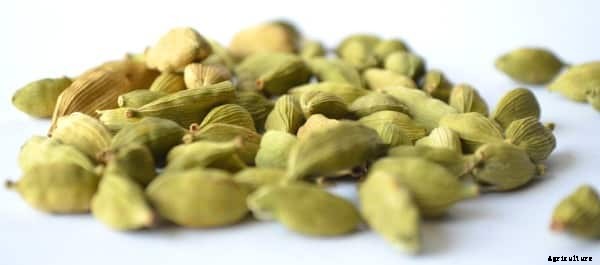 Cardamomo.
Cardamomo. - INTRODUCCIÓN: Esto también se llama cardamomo negro y su nombre binomial es Amomum subulatum. Las vainas tienen un fuerte aroma a humo y se utilizan como especia. El producto más grande es de Nepal. También tiene usos medicinales como el tratamiento de la ictericia.
- CONDICIONES DEL SUELO Y CLIMA: Esta especia se cultiva en elevaciones de 1000-2000 sobre el nivel medio del mar. Requiere una precipitación media anual de 3000-3500 milímetro . Profundo, Un suelo arcilloso bien drenado es bueno para estas plantas. Se debe mantener el pH del suelo. en 4.5-6.
- PROPAGACIÓN: La propagación de esta planta se realiza de forma vegetativa a través de rizomas o por semillas. Los rizomas de las plantas cultivadas se toman y procesan en grupos más pequeños y se plantan en hoyos.
- PREPARACIÓN Y PLANTACIÓN DEL TERRENO: Se considera pendiente moderada para el cultivo de esta planta. Pozos de dimensiones 30 x 30 x 30 centímetros están excavados con un espaciado de 5 x 1,5 m entre cada pozo durante el monzón. Los pozos están cubiertos con tierra vegetal y abono. Las plántulas se plantan en el centro del hoyo y el acolchado se realiza con hojas secas en la base de la planta.
- ABONO Y RIEGO: Estiércol de ganado y tortas de aceite no comestible utilizados como estiércol. Un mejor riego da un mayor rendimiento. El riego por aspersión se utiliza según la necesidad.
- MANEJO DE ENFERMEDAD: Las enfermedades fúngicas y bacterianas pueden ocurrir en esta planta. Las dos principales amenazas para esta planta son Chirke y Foorkey.
- COSECHA Y TRATAMIENTO: cuando la semilla de una cápsula se vuelve marrón, los macollos se cortan 30-35 cm y se dejan madurar para 10-15 más La recolección se realiza mediante un equipo denominado " Elaichichurri ’ y las espinas se amontonan. Las cápsulas se separan y se secan. El cáliz se quita frotando la cápsula con un alambre.
- PRODUCIR: La estimación muestra que un acre de tierra genera 2000 kg de cardamomo seco.
MENOR CULTIVO DE ESPECIAS DE CARDAMOMO:
- INTRODUCCIÓN: Esta especia es originaria del subcontinente indio y es la especia más necesaria de toda la lista. Es una planta de hoja perenne que se encuentra en los Ghats occidentales. El nombre binomial de esta especia es Elettaria Cardamomum L.La altura máxima de esta planta es de 2-4 metros y las variedades que se encuentran en la India son Mysore, Tipo malabar y vazhukka.
- CONDICIONES DE SUELO Y CLIMA PARA EL CULTIVO DE ESPECIAS DE CARDAMOMO: La temperatura y la lluvia óptimas requeridas para el cultivo de especias de cardamomo menor es a 10-35 grados Celsius y 1500-4000 milímetro precipitación anual respectivamente. El suelo arcilloso negro con rico humus, especialmente en el cinturón forestal, es el más adecuado para el cultivo de esta especia. El suelo arenoso no se prefiere en absoluto.
- PROPAGACIÓN: Se utilizan semillas o chupones para la propagación. Estas semillas se cultivan en viveros y se plantan en el área principal en condiciones adecuadas.
- PREPARACIÓN Y PLANTACIÓN DEL TERRENO: Fosas de 45 cm x 45 cm x 30 cm se excavan durante abril-mayo y se rellenan con abono y tierra vegetal. La plantación se realiza a lo largo de los contornos de una pendiente con espaciamiento de 2 mx 1 m . El inicio del monzón es ideal para plantar estas semillas y se trasplantan en verano al área principal con un espaciamiento de Los 20cm los x20cm . Se proporciona sombra y se suministra agua con regularidad.
- ABONO Y RIEGO: Nitrógeno a 90 gramos, Se requiere fósforo a 60 gramos y potasa a 120 gramos para un tamaño de cama de 5 mx 1 m. Esta dosis se suministra en tres pagos con un intervalo de 45 días entre cada uno. El contenido de fertilizante utilizado para este cultivo es nitrógeno a 75 kg, fósforo @ 75 kg y potasa @ 150 kg por hectárea si está siendo regado por fuentes externas, pero si los campos se riegan con lluvia, la ración de fertilizantes utilizados es de 30:60:30 kg / ha. El fertilizante total se aplica fraccionado y se aplica dos veces:una durante mayo y la otra en septiembre. 30 cm alrededor de la planta se aplican los fertilizantes. El riego es muy necesario durante la formación de la panícula, floración y formación de frutos. Hasta la llegada del monzón, el riego se realiza en un intervalo de 10-15 días.
- MANEJO DE ENFERMEDAD: Los trips y el barrenador de los brotes se controlan mediante la pulverización de monocrotofos al 0,025% (marzo-septiembre). Los pulgones se controlan mediante la pulverización de 0,05% de dimetoato. Los nematodos parásitos se controlan tratando las plantas con carbofurano 3g @ 5 kg a.i / ha. La pudrición de la cápsula se controla mediante pulverización. 1% Burdeos La pudrición del rizoma se controla tratando el suelo con 0,2% de oxicloruro de cobre .
- COSECHA Y TRATAMIENTO: Las plantas comienzan a dar frutos justo después de dos años de la siembra. La recolección se realiza durante los meses de octubre a noviembre. Los frutos recolectados se secan mediante secadora eléctrica a una temperatura de 45-50 grados por aproximadamente 14-18 horas .
- PRODUCIR: Se estima que una hectárea de tierra produce 1300 kg de cardamomo seco.
CULTIVO DE ESPECIAS DE CILANTRO:
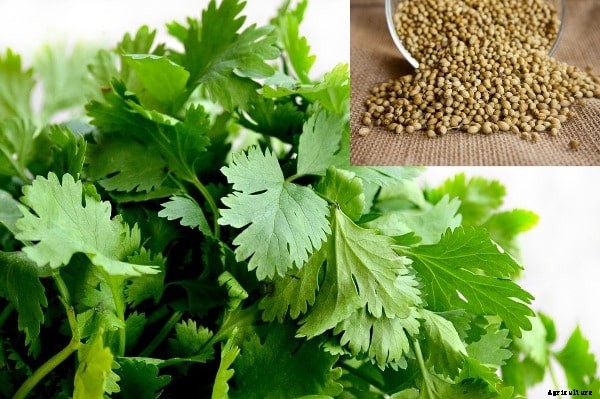 Cilantro.
Cilantro. - INTRODUCCIÓN: Esta es una hierba originaria de la región mediterránea. En la India, algunos estados cultivan cilantro, pero sobre todo es para uso local más que para exportación. Se exporta muy poco a otros países. El nombre binomial de esta planta es Coriandrum Sativum L. Es muy deseable por su sabor y aroma. Las hojas de la planta y los frutos secos se utilizan en la preparación de alimentos. Estas plantas herbáceas crecen hasta una altura de 30-70 cm. También tiene algunos usos medicinales.
- CONDICIONES DEL SUELO Y CLIMA PARA EL CULTIVO DE ESPECIAS DE CILANTRO: Esta planta es apta para el cultivo durante todo el año y es una variedad tropical. Todo tipo de suelo con rica materia orgánica es apto para su cultivo. El suelo de algodón negro se considera mejor con suficiente lluvia.
- PROPAGACIÓN: La propagación se realiza a través de semillas.
- PREPARACIÓN Y PLANTACIÓN DEL TERRENO: Después del inicio del monzón, la tierra se ara 3-4 veces y, dado que es un cultivo Rabi, la siembra de semillas se realiza durante octubre y noviembre. Necesita una hectárea de tierra 10-15 kg de semillas. Una mejor técnica de germinación es remojar las semillas en agua durante 12-24 horas antes de sembrar. Las filas de la finca están separadas por un espaciado de 30-40 cm y la profundidad máxima es de 3 cm.
- ABONO Y RIEGO : Se utiliza FYM a 10 toneladas / ha. Fertilizantes NPK @ 15 kg, 40 kg y 20 kg por hectárea respectivamente, para cultivos de regadío se requiere, mientras que para los cultivos de secano NPK a 20 kg, 30 kg, 20 kg por hectárea se requiere respectivamente. Se requieren 4-6 ciclos de riego durante todo el cultivo. Cada ciclo de riego se realiza con un intervalo de 30 a 35 días.
- MANEJO DE ENFERMEDAD: Los pulgones están controlados por la pulverización de malatión al 0,3% mientras que el gusano cortador se controla utilizando 4% de polvo de endosulfán a 20-25 kg / ha. El mildiú polvoroso y la enfermedad del marchitamiento se controlan rociando azufre húmedo. La agalla del tallo está controlada usando bavistina al 0.1% y el tizón se controla usando mancozeb al 0.2%.
- COSECHA Y TRATAMIENTO: Generalmente el cultivo se recolecta dentro 90-110 días . El cambio de color de la fruta de verde a marrón indica el momento de la cosecha.
- PRODUCIR: El rendimiento de los cultivos de secano es de 400-500 kg / ha y el de los cultivos de regadío es de 600-1200 kg / ha.
CULTIVO DE ESPECIAS DE FENUGREEK:
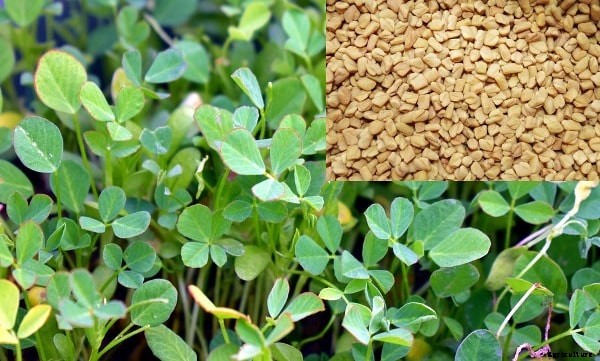 Fenogreco.
Fenogreco. - INTRODUCCIÓN: Esta hierba es originaria de Europa del Este y Asia occidental. Las hojas y las semillas se utilizan en la preparación de alimentos. Su nombre binomial es Trigonella Foenum-graecum L. La altura máxima del cultivo es de 0,9 m. Hay dos variedades principales de cultivos de T. Foenum-graecum (methi) y corniculata (kasuri methi).
- CONDICIONES DE SUELO Y CLIMA PARA EL CULTIVO DE ESPECIAS DE FENUGREEK: Tanto el clima templado como el tropical son adecuados para su cultivo. Durante la germinación de la semilla, la temperatura se mantiene alrededor 8-27 grados Celsius. Puede resistir las heladas y el clima extremadamente frío. Very low rainfall is required for this crop. Clayey loam is extremely good for these crops with a pH of 6-7
- PROPAGATION: Propagation is done by seeds. Seeds are soaked in warm water for 6-12 hours before sowing.
- LAND PREPARATION AND PLANTING: Ploughing is done thrice before sowing seeds and the soil beds are created uniformly with spacing between rows as 20-25 cm . In the plain area September to November is usually preferred for sowing the seeds, whereas in hilly areas the sowing is done in March.
- MANURING AND IRRIGATION: FYM @15 tonnes per hectare is used. NPK fertilizers @25 kg, 25 kg, 50 kg/ha respectively is required. Nitrogen is applied in two installments whereas the other two types of fertilizers are applied to the base of the crops at a time. 4-6 irrigation cycles are required during entire crop growth with an interval of 20-25 days between each cycle. Pre-irrigation is also done.
- DISEASE MANAGEMENT: root rot is caused by Rhizoctoni Solani and is controlled by drenching the soil with carbendazim 0.05%. Powdery mildew is controlled by spraying dinocap @20-25 grams/10 liters of water . Downy mildew is controlled by spraying 0.2% of difoltan solution.
- HARVESTING AND PROCESSING: Young shoots are removed within 25-30 days of sowing. The leaves are cut within 15 days of growth and minimum 2 cuttings are done before the flowering and fruit formation of the crop. The crops are removed when the pods dry and the entire thing is dried in the sun, which facilitates the removal of seeds by rubbing with the hands. Again the removed seeds are dried in the sun and packed.
- YIELD: One hectare of land produces 1200-1500 kg of seeds and 800-1000 kg of leaves.
ROSEMARY SPICE FARMING:
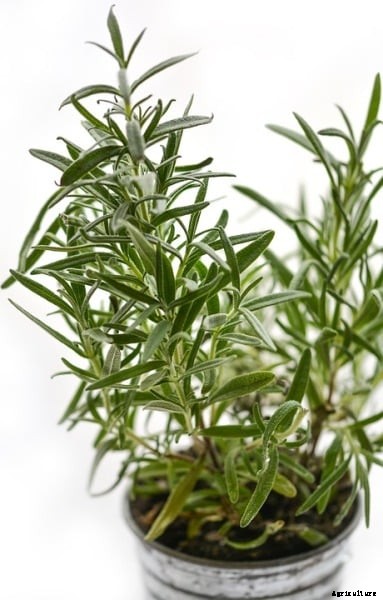 Romero.
Romero. - INTRODUCCIÓN: Rosemary is a perennial herb and is evergreen in nature. It is a native of the Mediterranean region and its binomial name is Rosmarinus officinalis. The shrub has a maximum height of 1.5m. This crop is famous for its aroma; las hojas, twigs and flowers are used for various purposes.
- SOIL AND CLIMATE CONDITIONS FOR ROSEMARY SPICE FARMING: Well-drained lateritic soil is best for the cultivation of rosemary crops. The pH of the soil is maintained in-between 5.5-7. 20-30 degree Celsius is the ideal temperature for its growth. Average annual rainfall of 10-20 cm is required a nd an altitude of 2500 m above sea level is considered good for growing rosemary.
- PROPAGATION: Seeds are used for growing rosemary plants, but with extreme care and typical conditions. Also cuttings, roots and layering are sometimes used to grow rosemary.
- LAND PREPARATION AND PLANTING: Land to be used for cultivation is ploughed two times and neem care is mixed as a source of manure. The spacing between rows of rosemary plants have to be 40-50 cm and beds of width 1-2 m is created. Initially the cuttings are raised in the nursery and then shifted to main area during midsummer.
- MANURING AND IRRIGATION: FYM @ 50 tonnes/ha, neem cake@1 ton/ha, natural compost@ 5 tonnes/ha and vermicompost @5 tonnes /ha as applied at the base of the crop during initial planting. Subsequent year onwards 5-30 kg per hectare is applied.
- DISEASE MANAGEMENT: This shrub is resistant to pests and fungus.
- HARVESTING AND PROCESSING: When the flowering starts the plants can be harvested. From second year harvesting is done every four months. The leaves are cleaned thoroughly and dried in shade for 10-15 days .
- YIELD: one hectare of land annually produces 2.5 tonnes of dried leaves of rosemary.
CHILLIE SPICE FARMING:
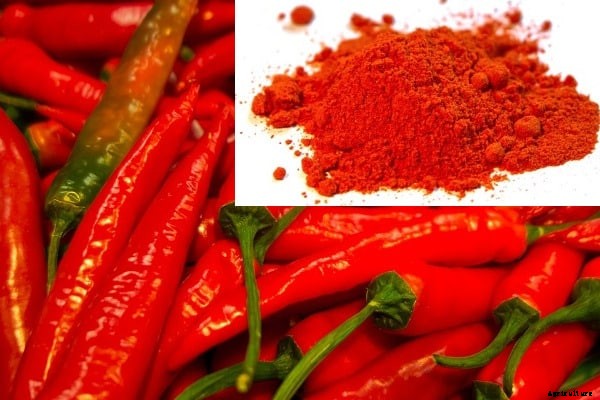 Chilli spice.
Chilli spice. - INTRODUCCIÓN: very common and needed Indian spice is chilli. It originated from Mexico, but the largest producer of chillies Japan. It is both a spice and a vegetable variety. The binomial name of the chili is capsicum annuum. It is a shrub
- SOIL AND CLIMATE CONDITIONS FOR CHILLIE SPICE FARMING: It needs warm, humid and dry weather. Temperature ranges from 20-25 degree Celsius . Temperatures beyond 35 degree effect the fruit development. Very little moisture is required to grow chillies. Well-drained sandy loam soil having high organic content is useful for growing chillies. The pH of the soil should be in-between 5-7.5. 2100 meters above mean sea level is the altitude up to which chillies can be grown.
- PROPAGATION: chilli propagates through seeds.
- LAND PREPARATION AND PLANTING: 2-3 ploughings are given to the soil before sowing seeds. Before sowing the soil is sterilized to make it free from fungus and other infections. Seeds are initially planted in nurseries and then transplanted to the main area. Coco peat is used to cover the soil with seeds and is lightly watered until seedling stage. The crop distance is 45 cm x 45 cm in the main area. Ridges and furrows of dimensions 60 x 45 cm is maintained for intercropping. Each raised bed of chilli is dimensioned as 30 x 120 cm .
- MANURING AND IRRIGATION: These plants do not require much water. Irrigation is done only when the moisture content of water drops to less than 25%. 1 kg of azospirillum with 50 g of FYM is used as manure.
- DISEASE MANAGEMENT: White ants are treated using 8-10 aldrin/acre. Fruit rot, die back, wilt, mildiú polvoriento, leaf spot is treated with 1% Bordeaux mixture. Neem cake @100 kg is used to destroy grubs.
- HARVESTING AND PROCESSING: Harvesting is done at regular intervals. They are dried in shade for 2-3 days.
- YIELD: One acre of land produces 30-40 quintals of fresh chillies and of which 25-35 kg of dried chillies is obtained from every 100 kg of fresh chillies.
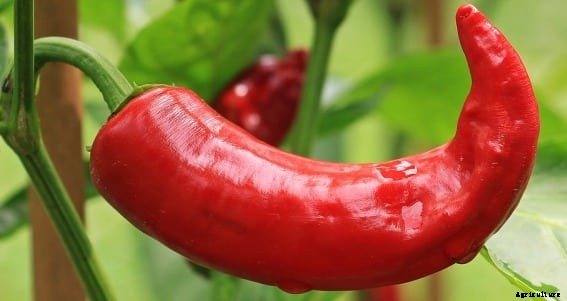 Red Chilli.
Red Chilli.
CELERY SPICE FARMING:
- INTRODUCCIÓN: The binomial name of celery is apium graveolens. It is an herb used for various purposes. The height of the herb is 10-14 inches and has white colored flowers. It is a native of the Mediterranean region.
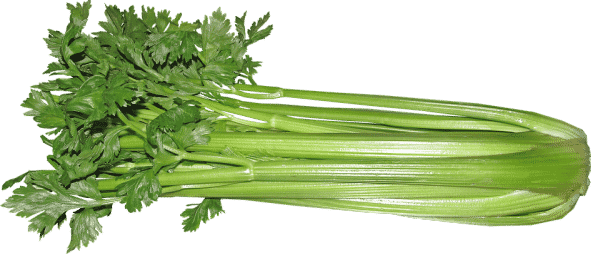 Apio.
Apio. - SOIL AND CLIMATE CONDITIONS FOR CELERY SPICE FARMING: During the growing stage it needs cold climate and during maturing it needs warm climate. A well drained loamy soil is considered good for this herb. The min temperature requirements are 12-30 degree Celsius with an average rainfall of 100 cm. The pH of the soil is maintained at 5.6 for good produce.
- PROPAGATION: propagation is done using seeds which are initially raised in a nursery and then transplanted to the main area.
- LAND PREPARATION AND PLANTING: Land is ploughed four to five times before planting. The spacing of these celery plants is 45 cm x 25 cm and the sowing depth is 2-4 cm. The seeds take 4-8 weeks for seedling and after 2 months, transplanted to the main area. November is the best time for sowing seeds.
- MANURING AND IRRIGATION: FYM @ 20-25 tonnes are used junto con nitrogen @200 kg, phosphorous @100 kg and potash @150 kg per hectare is required. Irrigation is highly essential and is given at an interval of 10-15 days.
- DISEASE MANAGEMENT: Damping –off, Fusarium yellows, early blight downy mildew is controlled by drenching the land with 400 grams of copper Oxy chloride .
- HARVESTING AND PROCESSING: 4-5 months after sowing, the crops are harvested.
- YIELD: one hectare of land yields about 25-30 tonnes of celery.
CUMIN SPICE FARMING:
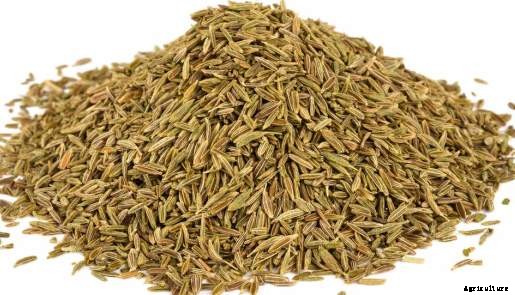 Cumin Seeds.
Cumin Seeds. - INTRODUCCIÓN: This is a flowering plant and native to the Middle East and India. Its binomial name is Cuminium Cyminum. Cumin is a herbaceous plant whose seeds is dried and used as spice. The height of this plant is 30-50cm. In Hindi it is addressed as jeera which is most famous and widely used spice in Indian cuisines.
- SOIL AND CLIMATE CONDITIONS FOR CUMIN SPICE FARMING: Sandy loam soil with high nutrient content is required for the cultivation of cumin. The soil should be well drained and should be able to hold moisture. Mild climate is required for its cultivation and winter weather is also suitable. Sunlight is highly essential for its growth.
- PROPAGATION: seeds are used for propagation.
- LAND PREPARATION AND PLANTING: sowing of cumin seeds is done in December and the rows are spaced 30 cm apart.
- MANURING AND IRRIGATION: FYM @ 12-15 tonnes/ha junto con phosphorus @20 kg, nitrogen @30 kg is applied to the soil. These fertilizers are applied in two splits. Initially the seedlings are lightly watered and the second irrigation is done after 7-10 days.
- DISEASE MANAGEMENT: Powdery mildew is controlled by spraying 20-25 grams /10 liters of water. Similar, Alternaria blight is controlled by spraying 0.2% of dinocap.
- HARVESTING AND PROCESSING: Complete maturity in plants is obtained within 100-115 days from sowing. Harvesting is done by uprooting the entire plant and drying it. The dried plants are thrashed to remove seeds.
- YIELD: An average yield is 5 quintals per hectare.
GINGER SPICE FARMING:
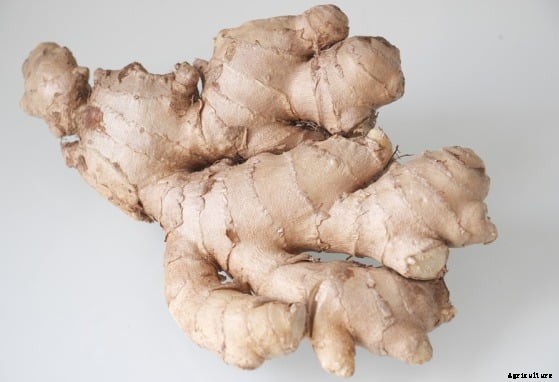 Ginger root.
Ginger root. - INTRODUCCIÓN: This spice is native to Asia and has high demand locally and internationally. It is an herb which grows to a height of 1 m and bears yellow flowers. This spice has many medicinal properties and refreshing aroma.
- SOIL AND CLIMATE CONDITIONS FOR GINGER SPICE FARMING: Cálido, humid climate is favorable for the growth of ginger. An altitude of 1400-1500 m is suitable for cultivation. This herb is grown in different soils. The pH of the soil should be 5-6.5.
- PROPAGATION: Propagation is done using rhizomes. The length of the rhizome should be 5-5 cm and should weight 20-25 grams .
- LAND PREPARATION AND PLANTING: 3-4 ploughings of land are done during summer. Crosswise harrowing is done to make the soil loose. A bed for the crops is made 1 m wide, 15 cm high . Each bed is separated by 50 cm. solarisation is done using polyethylene sheets for 40-45 days.
- MANURING AND IRRIGATION: FYM @ 15 tonnes/ha along with NPK @60 kg, 50 kg, 50 kg / ha respectively is used for growing these crops. Irrigation is provided at an interval of 8-10 days. Maximum 20 irrigation cycles are needed for the entire growing period. Drip irrigation is also preferred.
- DISEASE MANAGEMENT: Shoot borer is controlled by spraying 0.1% of Malathion. Rhizome flies are controlled by spraying 05% methyl parathion . Leaf roller and scales are controlled by spraying 0.05% dimethoate . Soft rot is controlled by captafol 0.1%. Leaf spot is controlled by a 1 % Bordeaux mixture . Root knot nematode is controlled by solarising. Bacterial wilt is controlled by spraying 200 ppm streptocycline .
- HARVESTING AND PROCESSING: Green ginger can be harvested in 215-220 days after planting the rhizomes. Yellowing of leaves indicates the harvesting season.
- YIELD: One hectare of land produces 10-15 tonnes of green ginger.
THYME SPICE FARMING:
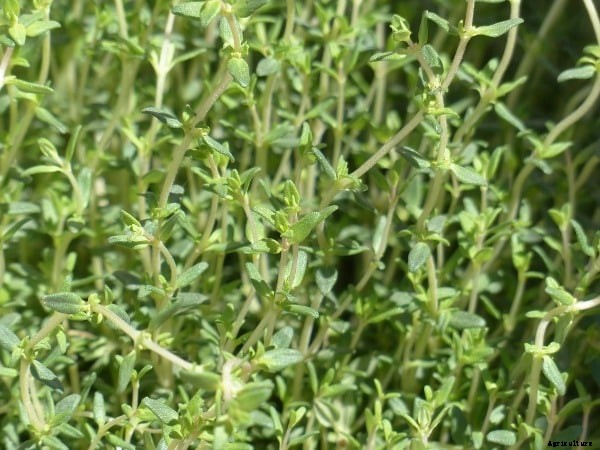 Hierba de tomillo.
Hierba de tomillo. - INTRODUCCIÓN: This is an evergreen herb with aroma, generally used for cooking and medicinal purposes. It originated from the Europe and spread throughout the world through Romans.
- SOIL AND CLIMATE CONDITIONS FOR THYME SPICE FARMING: Requires well drained, tierra fértil. Warm climate is suited for thyme plants and hill regions are considered best for cultivation.
- PROPAGATION: It is propagated through seeds and also vegetatively by plants.
- LAND PREPARATION AND PLANTING: ploughing is highly essential to prepare the land and plants are planted 15-30 cm apart. The spacing between the rows is 60 cm.
- MANURING AND IRRIGATION: FYM @ 50 tonnes/ha, vermicompost @ 5 tonnes/ha, neem cake @1.25 kg/ha, azospirillum and phosphobacterium and panchagavya is sprayed @3%.
- DISEASE MANAGEMENT: No major diseases occur to this plant.
- HARVESTING AND PROCESSING: For cooking purposes leaves and flowers are used. Harvesting starts from 4-5 months of sowing. The shoots are cut from the plant with a length of 15 cm. When the leaves dry, they curl and turn brown.
- YIELD: one hectare of land yield 1100-2200 kg of thyme.
CLOVE SPICE FARMING:
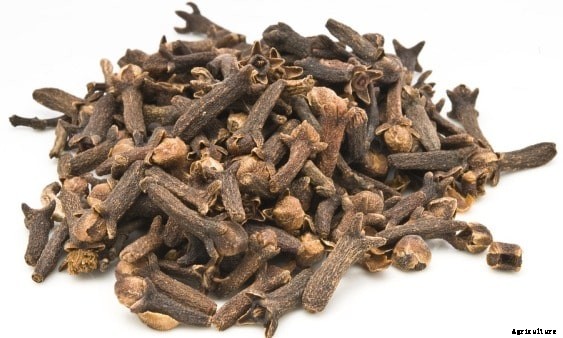 Cloves.
Cloves. - INTRODUCCIÓN: Clove is an evergreen tree with high medicinal properties. The binomial name is Eugenia caryophyllus and is native to the Indonesian island. This plant grows to a height of 7-15 m. The dry unopened flower bud of the plant is the clove. In India the Western Ghats are popular for clove cultivation.
- SOIL AND CLIMATE CONDITIONS FOR CLOVE SPICE FARMING: This plant requires a warm, humid climate of temperature 20-30 degree Celsius and an average rainfall of 150-250 cm . The altitude is generally estimated to be 1500 m above mean sea level. Black loamy soil with rich humus is well suited for clove cultivation. Sometimes it is also grown in clay loam and laterite soil.
- PROPAGATION: Seeds are used for the propagation of clove usually during June to October. The seeds are soaked in water before sowing.
- LAND PREPARATION AND PLANTING: Pits of dimensions 60 cm x 75 cm x 3 cm are dug with a spacing of 6-7 m and filled with topsoil. Planting of seeds is done at the end of the monsoon.
- MANURING AND IRRIGATION: Rotten cattle manure @15 kg is required initially, but as the plants grow, they need more manure. The manure is applied basally at a radius of 5 m del árbol. Pot watering is required if there is no sufficient water supply. Plants need subsoil irrigation during peak summer season.
- DISEASE MANAGEMENT:
- HARVESTING AND PROCESSING: yielding starts during 7 years, but to attain full bearing the tree takes 15-20 years . After flowering the buds take 4-6 months for harvesting. The buds are dried for 4-5 days.
- YIELD: One fully grown tree gives 4-8 kg of dried buds.
FENNEL SPICE FARMING:
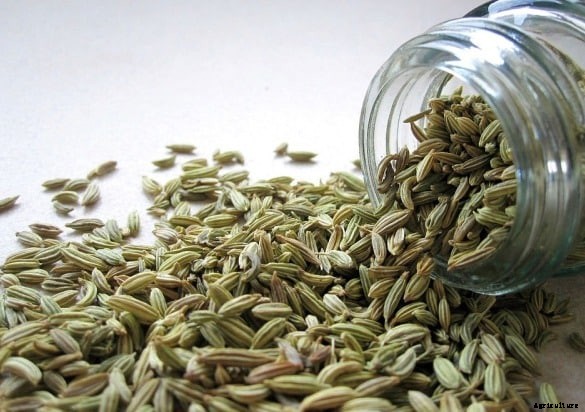 Hinojo.
Hinojo. - INTRODUCCIÓN: It is a flowering plant and native to the Mediterranean. This spice has an exclusive aroma and a different flavor. This herbaceous plant grows to a height of 2.5 m. The binomial name is Foeniculum Vulgare. In India it is addressed as Saunf in Hindi.
- SOIL AND CLIMATE CONDITIONS: Every kind of soil is suitable for the cultivation of fennel. But well drained sandy or loamy soil is best suited with a pH of 6.5-8. The optimum temperature for the cultivation of these crops is 15-25 degree Celsius with an average rainfall of 50-75mm .
- PROPAGATION: It is not a transplanting variety. Propagation is done through seeds directly sowed in the main area.
- LAND PREPARATION AND PLANTING: The land is ploughed two three times to prepare a fine seed bed. This plant is rarely raised in nurseries. Sowing is done during October and if it is a rain fed region, then spacing of 45 cm between rows with 10 cm crop spacing is maintained.
- MANURING AND IRRIGATION: Cow dung@4-6qtl/acre along with urea@45 kg/acre i s applied three times in equally split proportions. Pre-sowing irrigation is done and then at an interval of 10-15 days 10-12 cycles of irrigation is required during the entire duration of cropping.
- DISEASE MANAGEMENT: Aphids are controlled by spraying 0.03% of dimethoate . Seed midge and heliothis is controlled by spraying 0.07% of endosulphan .
- HARVESTING AND PROCESSING: Maturity of plants is known when seeds are full and green in color. The umbels are cut and dried in the sun for 2 days and then dried in the shade for 10 days. The crop harvesting is done in May i.e. after 180 days from sowing.
- YIELD:O ne hectare of land yields 10-11 quintals of fennel on an average.
BLACK PEPPER SPICE FARMING:
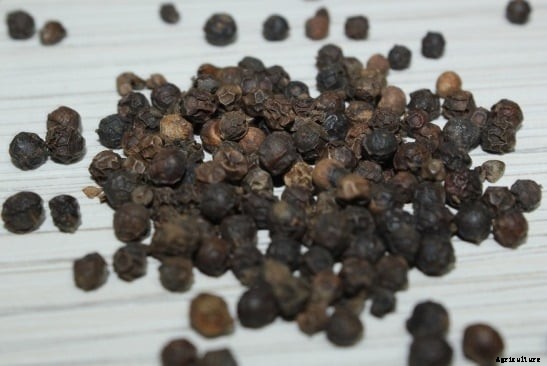 Black Pepper.
Black Pepper. - INTRODUCCIÓN: The binomial name of black pepper is ‘piper nigrum’ and it is an evergreen flowering vine. This plant in mostly found in south India and grows to a height of 10 m. This is the earliest form of spice in India. There are 75 cultivars of pepper in India of which Karimunda is most popular. Other varieties are kottanadan, narayakkodi, aimpiriyan, kuthiravally, balancotta, kalluvally, malligesara and uddagare.
- SOIL AND CLIMATE CONDITIONS FOR BLACK PEPPER SPICE FARMING: pepper plants require tropical humid climate with sufficient rainfall (125-200 cm). The submountaeous region of Western Ghats is exclusive for growth of pepper plants. Clay loam, red loam and lateritic soils are suitable for pepper farming. The pH value of the soil is maintained at 4.5-6.0. The temperature should be in between 10-40 degree Celsius.
- PROPAGATION: Cutting from runner shoots is used for propagation of pepper. One third of the root is cut and planted in the nursery. They are obtained in the month of February –March. Roots develop from the cuttings and they are set for planting.
- LAND PREPARATION AND PLANTING: level land with proper drainage is chosen for farming. South facing slopes are avoided, but north or north eastern slopes are preferred to avoid the effect of the sun. Planting is done in the monsoon. Square pits of dimensions 0.5 m x 0.5 m are dug and the spacing between the pits is 2.5 m x 2.5 m . Seedlings which are two years old are planted in the pits. When the vine grows, it is initially made to creep on a pole of 2 m height. After a certain length the temporary stake is removed and planted in a trench of depth and width equal to 15 cm close to the tree trunk.
- MANURING AND IRRIGATION: Rotten cattle manure@ 10 kg is used as manure for pepper plants. 100 grams of nitrogen, 40 grams of P2O5 and 140 grams of K2O is used as a fertilizer for three year old plants. 1/3
rd
of the above mentioned composition is applied in the first year and 2/3rd of the quantity is applied in the second year. Lime @500 grams is applied as fertilizer during later stages of development.
- HARVESTING AND PROCESSING: Yield starts after 3 or 4 years from planting. The ripening takes 6-8 months from flowering and harvesting is done during November till February. The entire spike is plucked when the berries turn bright red. The spike is rubbed with hands to remove the berries which are then dried in the sun for 7 to 10 days until the berries turn black.
- YIELD: 800-1000 kg of black pepper is obtained from one hectare of plantation land (7-8 yrs old). The yield reduces after every 20-25 years.
CINNAMON SPICE FARMING:
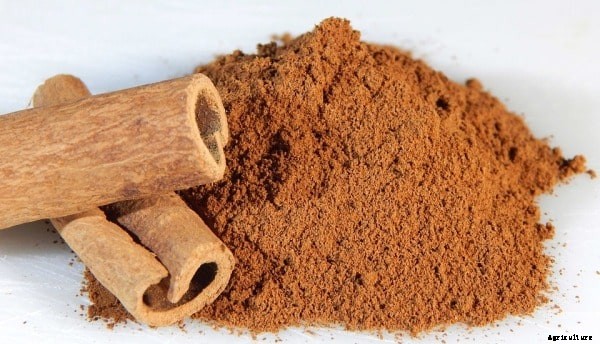 Cinnamon spice.
Cinnamon spice. - INTRODUCCIÓN: Cinnamon is the inner bark of the tree and is the first known spice with rich flavour. It is native to Sri Lanka. Also lower slopes of Western Ghats (Kerala and Tamilnadu) cinnamon cultivation are predominant. Binomial name is Cinnamomum Cassia.
- SOIL AND CLIMATE CONDITIONS FOR CINNAMON SPICE FARMING: lateritic and sandy soil is preferred for cinnamon plant. The elevation of land above sea level is approximately 1000 metros . This plant requires an annual rainfall of 200-250 cm .
- PROPAGATION :Cinnamon is propagated by rooted cuttings, air layering and seeds. 10 cm long with 2 leaves semi hardwood cuttings are dipped in keradix-B and planted in a polythene bag consisting of sand and coir dust mixture in the ratio 1:1. These are watered twice in a day and stored in the shade. Después 45-60 days the roots develop indicating that it can be transplanted to a another permanent place
- A ring from the semi hardwood bark is removed and IBA 2000 ppm is applied on it. This region is covered with coir husk and wrapped with 20 cm of polythene. Rooting starts after 40-60 days and the air layers are detached from the parent plant. These can be planted in the main area during monsoon
- For the sowing of seeds a mixture of sand, soil and rotten cattle manure in the ratio 3:3:1 is prepared and germination starts after 15 -20 days. Moisture is a must for these plants.
- LAND PREPARATION AND PLANTING: Pits of dimensions 50 cm x 50 cm x 50 cm are dug with space between each pit being 3m x 3m. The pit is initially filled with topsoil and compost and the seedling are planted. One acre land can accommodate 3600 pits
- MANURING AND IRRIGATION: 20 grams of nitrogen, 18 grams of P2O5 and 25 grams of K2O are used as fertilizer in the initial growth period. The dose increases with the age of the plants. Fertilizers are applied during may-June and September-October. Green leaves are used for mulching FYM @25 kg i s applied in May-June. Irrigation is essential during summer.
- DISEASE MANAGEMENT: Colletotrichum Gloeosporioides causes leaf spotting and die back disease. Diplodia sp. causes seedling blight. Pestalotia palmarum causes grey blight. All these are controlled by a 1 % Bordeaux mixture . Pests like leaf minor and cinnamon butterfly are controlled by the use of quinalphos (0.05%).
- HARVESTING AND PROCESSING: When the tree is grown to a height of 10-15 m in 4 years, shoots are available for peeling. Coppicing is done to encourage regrowth. Shoots of thickness 5-2 cm are chosen for the extraction of barks. 1-1.25 m of shoots are cut into straight pieces followed by scraping and peeling. The peels are dried in the shade and then in sunlight for 4 days. Dried barks take the shape of a quill. Grading of quills is done from 00000, 0 being the most coarse quality. Small bark pieces are called quillings; thin inner pieces are called featherings.
- Distillation of dried cinnamon leaves and barks produces oils. This oil is used in soaps, perfumes, cremas toothpastes etc.
- CULTIVARS AND YIELD: Two varieties are known in India, the Navashree and the Nithyashree. 56 and 54 kg of dry quills /ha /yr are obtained from Navashree and Nithyashree respectively. The product yield of Navashree is such that 2.7% bark oil, 73% cinnamaldehyde 8% oleoresin 2.8% leaf oil, 62% leaf eugenol. The product yield of Nithyashree is (2.7% bark oil, 58% cinnamaldehyde, 10% oleoresin, 3% leaf oil and 78% eugenol.
Read about Zero Budget Natural Farming.
Read about Hydroponic Growing System.



















